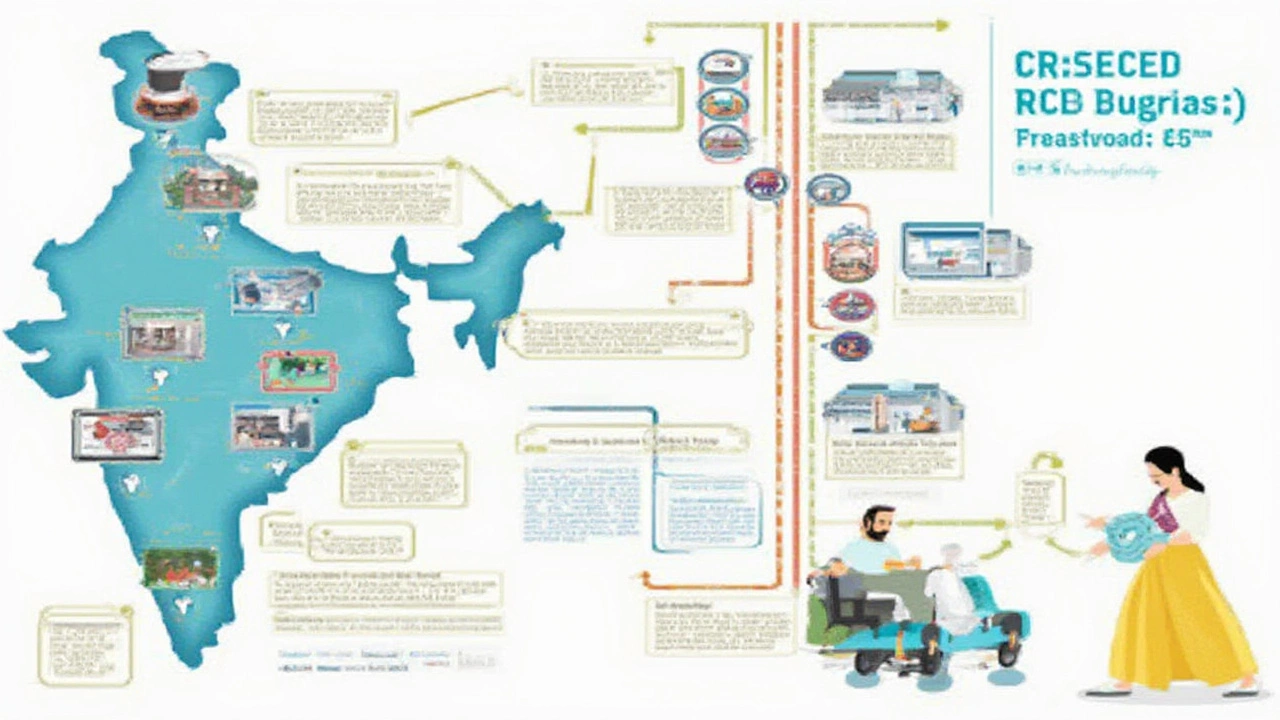If you think taxes are confusing, try figuring out who actually needs GST registration in India. The rules look simple until you hit the tiny print. One business trip to Mumbai and you’ll overhear someone grumbling about “threshold limits,” exports, or that one friend who ignored GST registration and now stares at scary government emails every morning. It matters—miss a step and you risk fines, business slowdowns, or even shut doors. Yet, skip the red tape with the right info, and you could save a lot of headaches and maybe some serious money. With business constantly shifting online and new categories popping up, understanding GST isn’t just for the finance nerds—everyone running a business or planning a side hustle should pause and pay attention.
Who Must Get GST Registration? Facts, Limits, and Exceptions
GST registration isn’t only for giant corporations. In India, any business whose turnover crosses a specific limit needs to register under GST rules—miss that threshold, and you’re in the clear; go past it, and you need that GSTIN pronto. As of July 2025, the standard annual threshold is ₹40 lakhs for most states if you deal in goods, and ₹20 lakhs for services. Some northeastern and hill states, like Assam and Himachal Pradesh, have an even lower bar, a ₹10 lakhs threshold for both goods and services—that’s barely the annual earnings of a tiny local store. The moment you hit this number, ticking off GST registration is non-negotiable by law.
There are a few special categories that must sign up no matter how tiny their turnover. That means if you run businesses like:
- Inter-state suppliers (even if they sell a single product across state borders)
- E-commerce sellers, no matter how much they sell
- Input Service Distributors (ISDs)
- Casual taxable persons (say, you set up stalls for only a few weeks at exhibitions)
- Non-resident taxable persons (folks not living in India but supplying goods or services)
- Those paying tax under reverse charge mechanism
- People selling through e-commerce platforms like Amazon or Flipkart (even if it’s only one sale)
If you get too popular on Instagram and start shipping cakes across state borders or launch a collection on a marketplace, you can’t fly under the radar—the GST department has automated alerts for cross-border sales and pan-India deliveries. I once chatted with a Sydney-based expat friend who ran a Diwali sweets delivery to India as a fun seasonal gig. She sold ₹18,000 in ladoos, but a single order to another state meant she technically fell under ‘inter-state supply,’ and had to do GST paperwork or risk issues with her payments platform and the Indian bank. It’s not about how much you earn but GST registration rules that care more about how and where you supply.
Businesses signing up get a unique 15-digit GSTIN (Goods and Services Tax Identification Number). This isn’t just a tax formality—anyone buying from you can instantly check if you’re a legit, registered entity. Large B2B companies almost always demand your GSTIN for their own accounting. Try selling wholesale to a supermarket or exporting through a freight forwarder—you’ll find GST registration isn’t just a rule, it’s the entry ticket to their supplier roster. Many business loans and even government schemes like MSME benefits need your GST registration too; those are the facts often skipped in official advice.
For fresh startups or folks freelancing from home: don’t look away yet. If you’re only selling within your city and staying below turnover limits, you’re fine for now. But if you run an online store, use dropshipping, or do digital services for clients outside your state, GST registration might be a must regardless of size. There’s no room for “I didn’t know”—the GST Council now matches PANs to bank deposits and e-way bills automatically. If you’re close to the limit or often get big payments, it’s better to register early and avoid future messes.
Here’s a quick table showing the main GST threshold limits in 2025 for simple reference:
| Type of Business | State Category | GST Registration Threshold (Turnover) |
|---|---|---|
| Goods | Normal States | ₹40,00,000 |
| Goods | Special Category States | ₹20,00,000 |
| Services | Normal States | ₹20,00,000 |
| Services | Special Category States | ₹10,00,000 |
| E-commerce seller, Inter-state supplier, Casual/Non-Resident | All States | No Threshold – Must Register |
Ignore these benchmarks, and sooner or later, a GST officer could slap you with a fine that’s often 100% of your unpaid tax, sometimes higher. There’s no “good faith” argument after the GST audit team emails, let me tell you—Serena, my other half, runs a consulting side business and we learned the hard way that GST deadlines don’t budge for anyone, not even during an “emergency” trip. Play it smart and check the current threshold for your state and sector before scaling up sales or running mega-promotions.

How to Actually Register for GST: A Step-by-Step Look
Okay, you qualify and need to register. Don’t get scared by the scattered guides online—registering for GST isn’t as nightmare-ish as you might think, if you follow the right path. You can apply online through the official GST portal, and most steps just require basic details plus digital copies of your proofs. Get your Aadhaar card, PAN, business registration docs, and a working Indian mobile number in hand before you start—otherwise, the OTP and e-sign process will drive you nuts. Here’s a straight-up walk-through of the main steps you’ll tackle:
- Go to the GST Portal: Head to gst.gov.in. Select “New Registration.” Fill in your details–business name, PAN, email, and phone. You’ll get OTPs (One Time Passwords) on both email and phone for verification.
- Get Documents Ready: For proprietors, you need PAN and Aadhaar; for firms/companies, you also need incorporation documents and partnership deed or company COI. Address proof, canceled cheque, and passport photos help things move faster. Assemble everything as high-res jpg/pdf files under 1 MB—uploading large or blurry scans often causes rejection.
- Fill in Application Form: The system leads you through sections: promoters, main business place, additional places, bank details, and product/services. Don’t fudge details—wrong info can lead to endless queries and delays. Always double-check your business type and activity codes (HSN/SAC codes)—these control your filing type and tax rates later.
- Verification and E-sign: The portal does Aadhaar authentication or digital signature (DSC) for companies. This step stumps many—if you hit a wall, try early mornings or late evenings to avoid server slowdowns.
- Application Tracking: You get an Application Reference Number (ARN). Add it to an Excel or email; you’ll need it for every followup. Approval can take 3-14 days, faster if docs are clear and match your PAN/Aadhaar details. You might get calls or emails for extra info or clarification—respond fast or they’ll cancel the request after 15 days.
Some pro-tips the guides often skip? Always match your GST address with your actual bank and utility records—discrepancies trigger rejections. For rentals, attach a rent agreement copy and latest electricity bill. If you run things from home, yes, you can use your house, just clarify ‘residential use’ in the application and add a letter of consent if the property is in someone else’s name. And don’t ignore emails from gst.gov.in—the system clocks your response time, and slow replies can mean fresh delays.
Registering early has benefits. You unlock Input Tax Credit (ITC), which means you can claim back the GST you pay on raw materials, utilities, marketing, and more—it’s like getting a partial refund on your business costs. Without GSTIN, all that extra tax is just lost expense. If you’re in a B2B game, buyers and suppliers won’t trust you without GST registration. Plus, certain government tenders, e-commerce platforms, and bank loans instantly reject unregistered entities.
It isn’t all tedious pain though. After registration, you only need to file GST returns monthly or quarterly (depending on your turnover), and simple tools or CA apps can do it for you. Just don’t forget your deadlines—late filings bring automatic late fees and sometimes freezing of your GST number. No warning, no mercy—a Sydney mate found his Indian company’s GSTIN suspended after a backlog of just two missed filings over Christmas, and it took a month to revive his business.
Bottom line? Registering for GST is less about extra work and more about staying future-proof. When your business grows, launches new products, or sells in new states, your GSTIN keeps you complaint and helps you expand without sudden panic. Even tiny freelancers benefit: with GST registration, you charge GST to bigger clients and claim credits, making your service more professional and competitive.

Tricky Scenarios, Compliance Tips, and FAQs on GST Registration
You might think you’re safe if you’re nowhere near the threshold, but GST rules love exceptions. If you’re a part-time designer in Kerala, and suddenly pick up a cross-border gig for someone in Delhi—boom, you’re into “inter-state supply.” Or maybe you swap from selling paintings locally to teaching art online to folks in Goa—this is “supply of services across states,” and GST registration is a must. Paytm and Razorpay now hold seller payouts until valid GSTINs are provided, a change nudged by government enforcement in 2024.
Here are some examples that trip up individuals and small teams:
- Affiliate marketers and influencers: As soon as you promote products and get paid for referrals outside your state, your earnings come under GST. Even if you’re just starting out, big platforms increasingly demand GSTIN for payouts. Check your contracts before the next viral campaign.
- Freelancers and agencies: Once you serve a client outside your own state—even by creating a logo or running a Facebook ad—GST laws kick in, and you have to register. There’s no “gig worker” loophole on these interstate services.
- Service export and foreign clients: If you’re exporting services (say, web work for the US or Dubai), you need GST registration to claim exemption and get paid without GST. Otherwise, Indian banks might withhold part of your foreign receipts or demand compliance proof.
- Partnerships or LLPs: Even a casual switch from cash sales to offering services online might suddenly push you over thresholds. If you restructure, merge, or go digital, run your numbers again on the GST portal calculator.
There’s also a “compulsory registration” list—certain businesses, no matter how much or how little they actually sell, must sign up. The best tip? Don’t wait for a GST notice; check online tools or consult a CA the moment your business phase or territory changes. Many skip GST thinking it’s a ‘future problem’ and end up paying double tax when retroactive fines arrive. Even filing a “Nil return” (no turnover) keeps your GST number active—it’s way simpler than reactivating after a suspension.
Quick FAQ rundown with facts that trip up people:
- Can I voluntarily register for GST even if I’m under the limit? Yes. Many freelancers, e-commerce sellers, and new startups do this for ITC (tax credit) claims and more professional image.
- What if I miss registering? Penalties are stiff—either 10% of unclaimed tax or ₹10,000 minimum, whichever is higher. If found intentional, it can go up to the full tax due, with stricter audits later.
- Can I get deregistered if my income drops? Yes, you can apply for cancellation through the GST portal if your turnover falls below limits or you shut business. Make sure you settle all returns and dues; dormant GSTINs attract fines.
- Do foreign companies need GST for selling in India? Yes—non-resident taxable persons must nominate someone in India for compliance and register, even for temporary pop-up sales or B2B services.
- Can I run multiple businesses with one GSTIN? Only if the businesses share the same PAN and location; otherwise, separate registration for each state or entity is required.
Don’t assume rules are frozen—GST Council reviews limits and categories every budget season. Save the GST portal’s official notifications in your bookmarks, and check every quarter or whenever your business changes size or shape. Cloud-based billing apps, some free and some paid, now offer GST auto-alerts; use them so you never miss filing. Serena, always the practical one at our house, runs an Airtable that tracks GST deadlines, payments, and filing receipts—don’t rely on just your email inbox to keep things compliant. When India’s tax tech runs on autopilot, even small mistakes lead to big surprises. Stay sharp so you can focus less on paper-chasing and more on actually growing your business.

